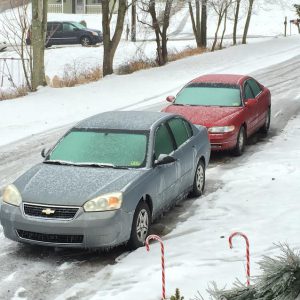By Chad Richards, Contributing Writer
It’s probably a scene you’ve seen a hundred times before: you wake up in the morning, and the ground and road are covered in a blanket of snow.
Depending on how old you were, you had one of two reactions. When you were young, you saw it as a full day of playing in the snow with school probably cancelled. As a college student, you are probably less excited because you have to drive in it. This means waiting for the plows and the salt, or simply going out and hoping for the best.
Winter isn’t the best time to be out on the roads, especially when our campus is located on top of 10 miles of winding roads. But, if you’re smart about how you approach the roads, you should be able to drive safely in the winter months.
Safe driving can start before you even go out on the roads by preparing for travel. The main thing you can do to prepare is to check traffic and road conditions. Each state has their own system and website to check, so if you’re traveling across state borders, you may need to check multiple websites. For example, West Virginia, Ohio, and Pennsylvania all have different websites as well as phone numbers you can call.
Of course, part of checking the road conditions include checking the weather conditions. There are many resources to check the weather online, and there are also reports on the local news.
Most reports will likely tell you if you should expect difficult driving conditions. If not, there are a few warning signs for ice forming, like temperatures at or below freezing and rain or snow falling. The amount is not as important, because ice can form on the roads with even a small amount of precipitation.
You can also get alerts sent to your phone through Twitter. One account to follow is @NWSCharlestonWV, which is the National Weather Service office for the state of West Virginia. There you can get alerts for any incoming bad winter weather.
 You can also prepare for winter weather by preparing your car. Be sure to have jumper cables, an ice scraper, and road salt, among other things. You can check out a full list here.
You can also prepare for winter weather by preparing your car. Be sure to have jumper cables, an ice scraper, and road salt, among other things. You can check out a full list here.
When you’re out on the roads there are many things you can do to keep yourself safe as well as the others around you. The most important thing is to slow down. There is no reason to be doing highway speeds on the highway when it’s covered in snow. It may take longer to get to where you’re going, but it will be much safer.
You have to remember to do everything slower, for that matter. You should turn slowly, brake slowly, and put on the gas slowly. Doing things slowly in difficult road conditions is the best way to stay safe.
If the temperature is near freezing but the roads haven’t frozen over, you still need to watch out for ice on bridges. Bridges are out in the air, meaning they can freeze and form ice before the road does.
If you can avoid it, try not going up hills. If you slide on a hill, you’ll start going down uncontrollably and will possibly end up injuring yourself or others. If you have to go up hills, don’t try to hit the gas up the hill because that will make things worse. Instead, try to get speed before going up the hill so you can coast up.
Finally, some cars may have special tires or features like traction control or four-wheel drive to help driving in the snow. While they are good features to have, they can’t work miracles. You shouldn’t put all your trust in these features and drive overconfident because that can lead to an accident. In fact, accidents in SUVs and four-wheel drive vehicles are as common if not more so.
While winter may seem like a bad time to be on the roads, it’s not all that bad. As long as you prepare by checking conditions and drive safe and smart, you’ll be able to handle the winter season.
Photo credits: AAA Exchange, Daniel Morgan







